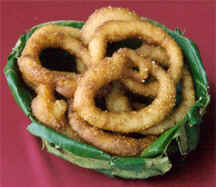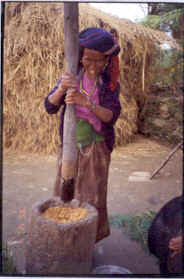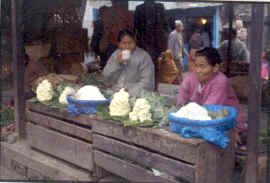| TRADITIONAL FERMENTED FOODS AND BEVERAGES OF THE SIKKIM HIMALAYAS |


 Sikkim is a mountainous state of India with an area
of 7096 sq. km and altitudes ranging from 300 m to 8500 m. The state comprises
four districts® North,
East, South and West. The total population of Sikkim is 540,493 (Census 2001) and
comprises three major ethnic groups of people, the Nepali, the Bhutia and
the Lepcha. The food culture of the Sikkim Himalayas is reflected in the
pattern of food production. Agriculture forms a major component of a mixed
farming system. Depending on the altitudinal variation, the main agricultural
crops are rice, maize, finger millet, wheat, buckwheat, barley, vegetable,
potato, soybeans, large cardamom, ginger, and a variety of seasonal vegetables
such as cabbage, brinjal, chili, mustard leaves, cucumber, pumpkin, sponge
gourd, radish, carrot, tomato, etc. Preparation of wild edible plants including
bamboo shoots, ferns and their parts such as seeds, fruits, roots, leaves,
flowers in local diet is an important component of food culture. Seasonal fruits
such as orange, apple, banana, etc. are grown and eaten. Livestock mostly plays
a subsidiary role in the mixed farming system. Cattle rearing is common for
milk, milk products and meat. Yaks (Bos grunniens) are reared mostly on
extensive alpine and sub alpine scrub lands between 2100 m to 4500 m altitude
for milk products and meat.
Sikkim is a mountainous state of India with an area
of 7096 sq. km and altitudes ranging from 300 m to 8500 m. The state comprises
four districts® North,
East, South and West. The total population of Sikkim is 540,493 (Census 2001) and
comprises three major ethnic groups of people, the Nepali, the Bhutia and
the Lepcha. The food culture of the Sikkim Himalayas is reflected in the
pattern of food production. Agriculture forms a major component of a mixed
farming system. Depending on the altitudinal variation, the main agricultural
crops are rice, maize, finger millet, wheat, buckwheat, barley, vegetable,
potato, soybeans, large cardamom, ginger, and a variety of seasonal vegetables
such as cabbage, brinjal, chili, mustard leaves, cucumber, pumpkin, sponge
gourd, radish, carrot, tomato, etc. Preparation of wild edible plants including
bamboo shoots, ferns and their parts such as seeds, fruits, roots, leaves,
flowers in local diet is an important component of food culture. Seasonal fruits
such as orange, apple, banana, etc. are grown and eaten. Livestock mostly plays
a subsidiary role in the mixed farming system. Cattle rearing is common for
milk, milk products and meat. Yaks (Bos grunniens) are reared mostly on
extensive alpine and sub alpine scrub lands between 2100 m to 4500 m altitude
for milk products and meat.
 Traditional fermented food has always been a rich ingredient to the Sikkimese culture. The Bhat-dal-tharkari-achar
(rice-legume soup-curry-pickle) constitutes the daily food supply in the meal (Tamang,
2000a). Daily per capita consumption of fermented foods in Sikkim is 87.6 g and
in the Darjeeling hills, 60.9 g, representing 9.8 % and 6.8 % of the total
daily food consumed in local diet, respectively (Yonzan and Tamang, 1998).
Selected microorganisms harbour on to the substrates and optimum condition
provide by the people, helps to get new products. These inexpensive culturally
acceptable traditional foods provided basic diet
Traditional fermented food has always been a rich ingredient to the Sikkimese culture. The Bhat-dal-tharkari-achar
(rice-legume soup-curry-pickle) constitutes the daily food supply in the meal (Tamang,
2000a). Daily per capita consumption of fermented foods in Sikkim is 87.6 g and
in the Darjeeling hills, 60.9 g, representing 9.8 % and 6.8 % of the total
daily food consumed in local diet, respectively (Yonzan and Tamang, 1998).
Selected microorganisms harbour on to the substrates and optimum condition
provide by the people, helps to get new products. These inexpensive culturally
acceptable traditional foods provided basic diet as staple, adjunct, pickle,
confectionery, condiment and alcoholic beverages which supplement enhanced
nutritional quality, palatability and wholesomeness of the product with acceptable
flavour and texture. Varieties of traditional fermented and non-fermented
foods are prepared, cooked and consumed in the Sikkim Himalayas (Tables 1 &
2). Women in these regions, using their indigenous knowledge of food fermentation,
mostly prepare these traditional foods.
as staple, adjunct, pickle,
confectionery, condiment and alcoholic beverages which supplement enhanced
nutritional quality, palatability and wholesomeness of the product with acceptable
flavour and texture. Varieties of traditional fermented and non-fermented
foods are prepared, cooked and consumed in the Sikkim Himalayas (Tables 1 &
2). Women in these regions, using their indigenous knowledge of food fermentation,
mostly prepare these traditional foods.
| Introduction | Ethnic Food Tourism | Fermented Products | Non-Fermented Products | Home |